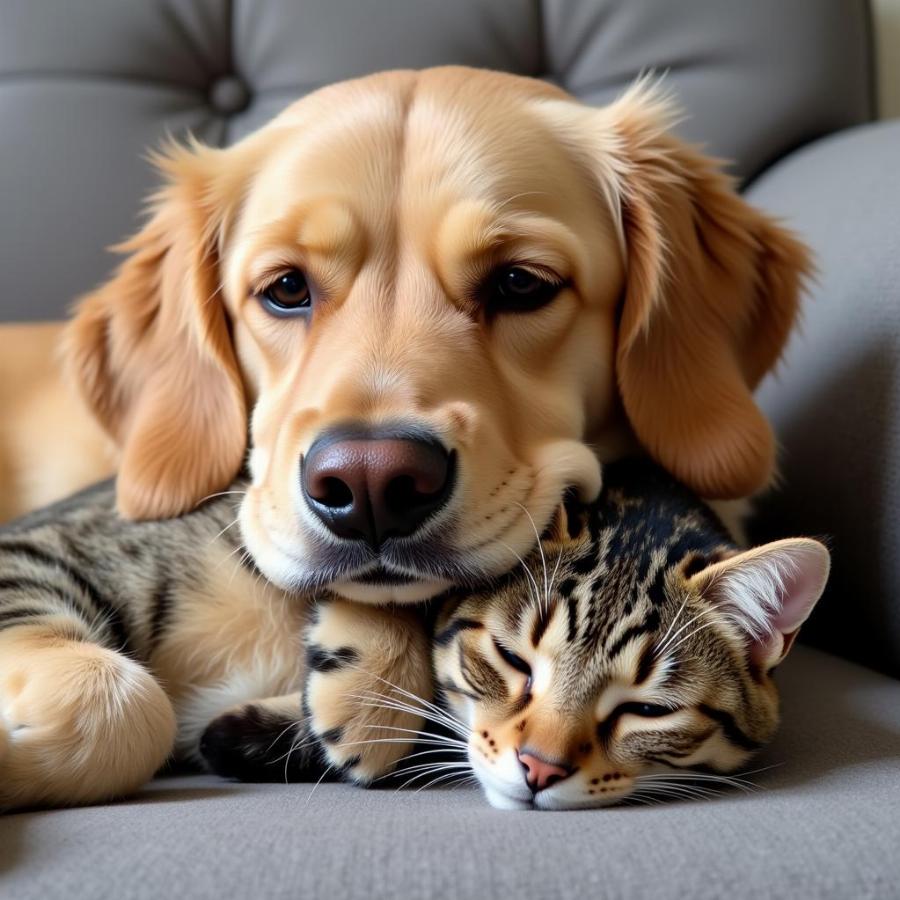The age-old question: can dogs and cats truly be friends? While cartoons often depict them as sworn enemies, the reality is far more nuanced. With patience, understanding, and the right approach, dogs and cats can absolutely coexist peacefully, and even develop strong, loving bonds. This article will explore the dynamics of a dog-cat relationship, offer practical tips for successful introductions, and address common concerns about bringing these two species together.
Understanding the Dog-Cat Dynamic
Dogs and cats communicate differently. Dogs are often boisterous and expressive, while cats are more reserved and subtle. This difference in communication styles can sometimes lead to misunderstandings. A dog’s playful pounce might be interpreted as aggression by a cat, while a cat’s hiss might be seen as a challenge by a dog. Understanding these differences is the first step to fostering a harmonious relationship. One key is to respect each animal’s individual personality and provide them with their own space. A comfortable, elevated dog cot can be a great way for a dog to have their own designated area, especially if the cat prefers higher ground.
 Dog and cat cuddling on a sofa, showing a peaceful coexistence.
Dog and cat cuddling on a sofa, showing a peaceful coexistence.
Introducing Your Dog and Cat: A Step-by-Step Guide
Introducing a dog and cat requires patience and careful planning. Don’t expect them to become best friends overnight. Start by keeping them separated, allowing them to get used to each other’s scents. Feed them on opposite sides of a closed door, gradually moving their bowls closer over several days. Next, allow brief, supervised visits, always ensuring both animals have an escape route. Positive reinforcement, such as treats and praise, can help associate the other animal with good things. Remember, gradual introductions are key to long-term success.
Addressing Common Concerns: Aggression, Territory, and Play
One common concern is potential aggression. While some dogs have a higher prey drive than others, proper training and socialization can significantly mitigate this risk. Establishing clear boundaries and providing each pet with their own space can also help prevent territorial disputes. For example, consider a metal outdoor dog kennel if you have a large yard, giving your dog a dedicated outdoor area. This helps define territory and allows both pets to have their own designated zones. It’s important to remember that play between dogs and cats can look different than play between two dogs. A cat’s swat might not be aggression but rather a way of setting boundaries. Always supervise interactions and intervene if play becomes too rough.
Can a Dog and Cat Share a Bed?
While it might seem adorable to see your dog and cat snuggled up together, it’s important to consider their individual preferences. Some pets enjoy sharing a bed, while others prefer their own space. Cooling dog beds are a great option for dogs who tend to overheat, and they can also provide a comfortable retreat for dogs who prefer to sleep alone. Respecting each pet’s boundaries and providing individual sleeping areas can contribute to a more harmonious household. Where you live can also influence the dynamics between your pets. If you’re considering getting a dog in a smaller apartment, understanding the spatial needs of both a dog and a cat is crucial.
Conclusion
Bringing a dog and cat into the same home can be a rewarding experience. With careful planning, patience, and a focus on understanding each animal’s unique personality, you can create a loving and harmonious environment where your dog mates cat, not in the literal sense, but in the spirit of companionship and peaceful coexistence. Remember to respect their individual needs, provide them with their own space, and supervise their interactions. By following these tips, you can pave the way for a successful and enriching multi-species household.
FAQ
- How long does it take for a dog and cat to get along? It varies, from a few weeks to several months.
- Is it easier to introduce a puppy to a cat or an adult dog? Generally, puppies adapt more easily.
- What are the signs of a stressed cat? Hiding, hissing, and changes in eating habits.
- What if my dog chases my cat constantly? Consult a professional dog trainer for guidance.
- Can a dog and cat share a water bowl? It’s best to provide separate bowls.
- How can I tell if my dog is playing too rough with my cat? Look for signs of fear or distress in the cat, such as flattened ears, hissing, or trying to escape.
- Are there certain dog breeds that are better with cats? Some breeds are known for being more cat-friendly, but individual temperament is key.
Other Questions You Might Have:
- How to introduce a new cat to a resident dog?
- What are the best toys for dogs and cats to play together?
- How to prevent territorial issues between dogs and cats?
For information about creating a comfortable outdoor space for your dog, check out our article on metal outdoor dog kennels. If you’re looking for comfortable and supportive bedding for your dog, you might find our article on elevated dog cots helpful. Finally, if you’re thinking about where to own a dog, you can find some valuable insights on our website.
Beaut Dogs: Your Trusted Resource for Dog Care
Beaut Dogs is your one-stop shop for all things dog-related, from breed information and care tips to product recommendations. We’re dedicated to providing you with the most up-to-date and reliable information to help you be the best dog owner you can be. When you need assistance, don’t hesitate to contact us by Email at [email protected], and Beaut Dogs will provide detailed and accurate answers. We’re passionate about helping you create a happy and healthy life for your furry friend. Visit us at https://beautdogs.com.